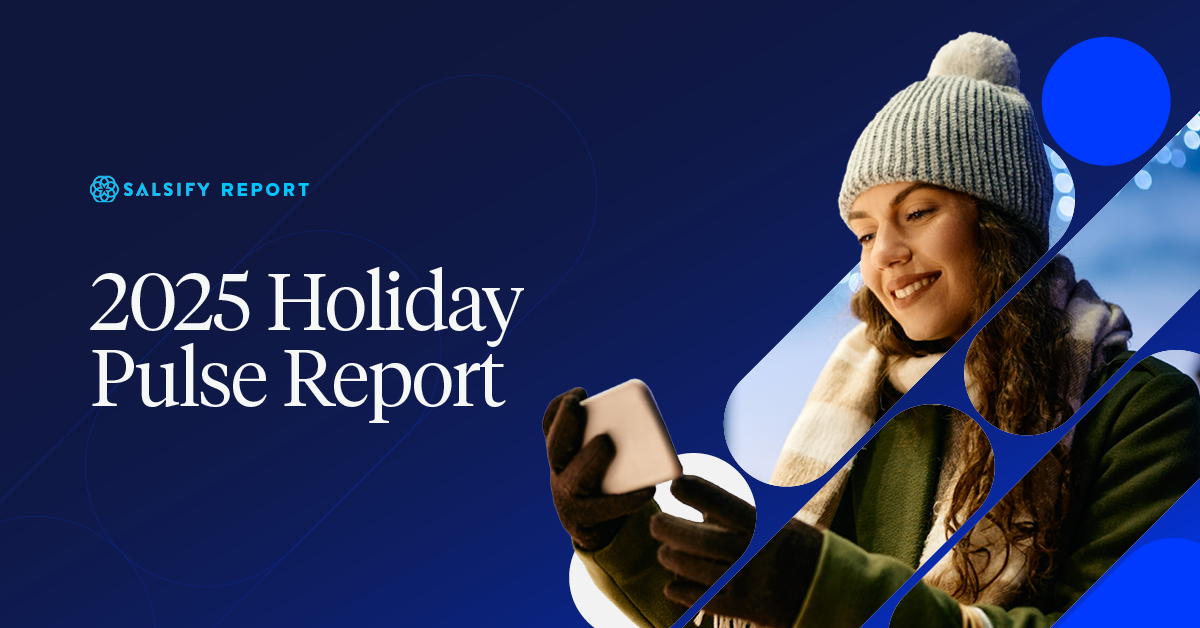Could AI in Retail Reduce Post-Holiday Returns?
Written By: Yvonne Bertovich
Maybe it’s the sugary haze from too much pie, the brain fog from eight rounds of less-than-enlightened debate with the in-laws, or the grogginess from inconsistent holiday slumber — but the post-holiday blues are real — and so are post-holiday returns.
It's a fact of life for brands: Every year, online orders are returned after the holiday season.
CapitalOne Shopping reports that ecommerce or online sales returns increased more than 39% from 2023 to 2024 while in-store returns increased nearly 9%. The totals? In 2024, consumers returned $362 billion in merchandise from online sales and $324 billion from in-store sales.
For global brands and retailers to prepare for the excitement and post-holiday returns (especially from online purchases), they must examine how they’re implementing artificial intelligence (AI) into their tech stack.
This begs the question: Can AI in retail help consumers, brands, and retailers, collectively reach a level of copacetic and mitigate post-holiday returns?
This post will cover AI in retail examples, AI in the workforce, and how these tools — when implemented thoughtfully — can make this upcoming holiday season all the merrier.
AI in Retail Examples
Digital transformation efforts of leading brands and retailers have been using AI in ecommerce and implementing AI in retail for a while now.
The global AI in retail market size was estimated to be more than 11.6 billion in 2024 and is projected to reach more than 40.7 billion by 2030, per Grand View Research. And, in terms of revenue share, North America took more than a third (33.4%) in 2024 as the largest market, with Asia Pacific as the fastest-growing market.
But how exactly is AI in retail being used, and what are the potential impacts (and benefits) on the shopping experience and post-holiday returns?
1. Order Right the First Time With Enhanced Product Recommendations
So, with slight shame, a customer walks up to a return counter (or visits a return landing page) and is greeted by the question, “Is there anything wrong with the item?” Maybe there was, maybe there wasn't — maybe it's as finicky as a change of mind. (We're only human.)
However, implementing AI in retail can enhance product experiences, product detail pages (PDPs), and product recommendations based on the consumer’s preferences and browsing history to help ensure they make the right choice the first time.
Increase the delight before the sale is made, reduce the likelihood of a return thereafter.
Plus, 37% of shoppers buy more frequently due to personalized recommendations, per consumer research from Salsify and the Digital Shelf Institute (DSI).

These implementations can also help you organize your product catalog and guide consumers along their buying journey (and across the digital shelf) in an intuitive, automated way.
2. AI in Retail Enables Virtual Try-On and Augmented Reality (AR)
Many shoppers return an item due to it being the wrong size, clothing fit, or product dimensions.
It’s discussed ad nauseam how it’s up to brands and retailers to seamlessly blend their presence on digital and physical channels. And also discussed ad nauseam is the challenge the digital shelf presents of consumers not being able to physically feel or see an item in their space before they buy.
AI in retail's best remedy for this issue is virtual try-on and augmented reality (AR) in retail.
Though it doesn’t fully resolve the dilemma of consumers not being able to touch and feel clothing, for example, it does allow them to have a much better idea of how the item will look on, if the color or cut will flatter them, etc.
Beyond clothing, AR and in-room 3D modeling can almost perfectly replicate how furniture, art, and other odds and ends will complement a consumer’s space — no more fiddling with a tape measure or guesstimating with arms’ lengths.
And beyond clothing and furniture, equipping your shopping experience with interactive elements such as these doubles as entertainment.
Consider how to implement this tech into your shopping experiences — after all, it can easily integrate into tech that's already in the palm of shoppers' hands. Fifty-nine percent of consumers say smartphones are their preferred device for online purchases, per Salsify consumer research.

3. Chatbots, Shopping Assistants, and Agentic AI Address Questions and Concerns Prior to Purchase
The holiday season can be particularly hectic on and off the clock. Try as they might, your customer service team may not have as much time to address all the questions that roll in — which will likely increase in volume during the holidays anyway.
Employing an AI chatbot or AI shopping assistant can take some strain off of your teams and better organize nuanced cases as they arise. They can even help employees infuse better recommendations and offers to delight consumers or upsell.
As a brand or retailer selling in the U.S., for example, an AI tool could be particularly impactful on apparel returns for a few reasons:
- Fashion and apparel continues to be in the top two verticals of interest for both Amazon Prime Day purchases and holiday gifts, per recent Salsify consumer research.
- According to Statista, clothing and shoes are the most returned online purchases, with 25% of shoppers reporting they've made an apparel return in the past 12 months, and 17% having done so for shoes.
Additionally, AI chatbots and agents can leverage additional information that positively influences and informs purchases, such as reviews and UGC. An informed consumer is a returning customer (the good kind of returning).
For example, a customer can ask a chatbot, “Is this item true to size?” Or, “Are these pillow covers washable?” without having to sift through reviews or FAQs themselves.
With AI agents, such as Amazon's Rufus or Walmart's Sparky, consumers can get increasingly granular, such as "suggest items to plan a birthday party for my excitable, 60lb Labrador who's turning six and loves the color blue."
4. AI in the Workforce Empowers Intelligent Inventory Management
“AI in the workforce” might stoke fears of replacing employees, but the reality is, AI will predominantly serve as another teammate and take on repetitive tasks or otherwise complex data lift. Per The Washington Post, a replacement of any grand scale won’t happen anytime soon (if ever), as even something as useful-sounding as an autonomous floor cleaner can be problematic.
Using AI in retail to inform inventory management can ensure popular items stay in stock throughout the holiday season. Therefore, consumers will get what they actually want the first time rather than trying to find a replacement they (or a gift recipient) might want to return.
For consumers shopping in-store, AI in retail can help consumers, or help employees help consumers find the preferred items more quickly.
AI in retail can also recommend promotions in effective contexts. If a consumer can save on an item and enjoy their shopping experience, they’re more likely to keep what they buy and return to buy more.
In terms of AI helping with context, for example, it can help you sort contacts and determine that you shouldn’t send a discount for dog beds to a customer who’s only ever bought a heat lamp for a bearded dragon — that’s a wasted offer.
5. Quality Control (QC) and Customer Feedback Analysis
AI tools are another way to bridge the gap between the digital and physical, the human and computer (and AI tools can even help with brand messaging).
Implementing AI for quality assurance, for example, doesn’t have to replace human QC agents, but rather serves as another line of defense against error, especially around hectic holiday schedules.
If a consumer receives the wrong item, or not all of the parts for their item, for example, they might get so annoyed (perhaps rightfully so) that they’ll just return the item rather than give your brand another chance.
And, even more likely, if a consumer receives a broken or defective item, they’re even less likely to return (after making their return).
Related, AI can more quickly catch onto items, inquiries, or issues that are arising when analyzing customer feedback. They can then quickly sort and even predict recurring or critical issues.
You and your teams can then spend less time worrying about problems occurring or finding the problem and instead focus on executing solutions.
Beat the Post-Holiday Blues (and Rising Return Rates)
The post-holiday blues and high return rates don’t have to do your brand in. With a bit of creativity and the thoughtful application — or adjusting — of AI tools in your tech stack over the next few months, you’ll be more than equipped to make the sales that consumers will want to keep. And that’ll keep everyone’s spirits high.

2025 Holiday Pulse Report
Download the report for exclusive consumer research, top industry trends, and growth hacks to help make this holiday season a smash hit.
DOWNLOAD REPORTCHEAT SHEET: Ecommerce AI Prompts
Check out this handy cheat sheet for details on how to use AI for competitive analysis, SEO research, and product page optimization.
DOWNLOAD CHEAT SHEETWritten by: Yvonne Bertovich
Yvonne Bertovich (she/her) is a senior content marketing specialist at Salsify, reporting from Tampa, Florida. With a longtime passion for research, she enjoys flexing her perspective on ecommerce, trends in consumer behavior, and health and wellness.
Recent Posts
Do Brands Need Social Media Influencers In The Age of AI?
How Can Brands Align With Consumers’ New Year’s Resolutions?
5 Ecommerce Tips To Help Marketers Enter the New Year Stress-Free
Subscribe to the Below the Fold Newsletter
Standing out on the digital shelf starts with access to the latest industry content. Subscribe to Below the Fold, our monthly content newsletter, and join other commerce leaders.

.svg)